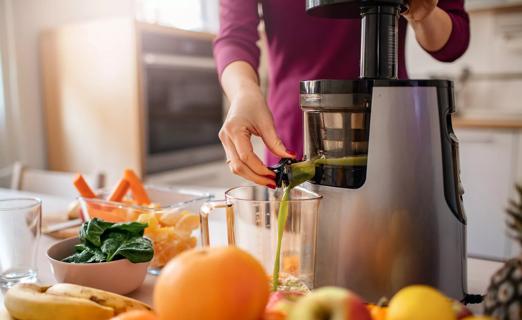Add these foods to help you lose

Frozen yogurt instead of ice cream. Roasted chicken in place of a hot dog. Nuts, not potato chips. A fruit smoothie over a milkshake.
Advertisement
Cleveland Clinic is a non-profit academic medical center. Advertising on our site helps support our mission. We do not endorse non-Cleveland Clinic products or services. Policy
What if you concentrated on eating more foods that are good for you rather than trying desperately to completely avoid the bad ones? Can you actually eat more and still lose weight?
Yes, it’s possible says registered dietitian Julia Zumpano, RD, LD. She walks us through what foods to eat and gives us tips on how to add healthy foods to our lives.
Most trendy diets include some sort of restriction — like cutting out carbohydrates, fats or dairy products — which makes the diets hard to sustain. Typically, once you stop following the diet’s restrictions, the weight comes right back.
“However, if you focus on adding more nutritious foods to your meals, as opposed to restricting foods, you’ll be more likely to lose weight and keep it off,” advises Zumpano. “You won’t feel like you’re depriving yourself, so you’ll be more likely to maintain healthy eating habits.”
And, if you concentrate on incorporating a certain amount of healthy food into your meals every day — like aiming for between seven and nine servings of fresh fruits and vegetables — you may find that you’ll naturally limit the not-so-healthy choices.
Eat these foods to lose weight and to improve your health in general.
Beyond being a great option for smoothies or a snack, fruits are jam-packed with many different vitamins and antioxidants.
Advertisement
Opt for fruits like apples, blueberries, bananas, oranges, strawberries and pineapple.
“Fruit can be high in natural sugar and carbohydrate, but portion control is key,” says Zumpano. “A serving of fruit is about 4 ounces or just under 1 cup of fruit. Fruit can satisfy that sweet tooth without any added sugar or cravings.”
Turn to veggies like spinach, broccoli, Brussels sprouts, peas and cauliflower, which are full of fiber.
That fiber expands in your stomach making you feel full so you can cut back on your main course portions to accommodate the extra calories.
“Keep in mind that vegetables are the lowest calorie food group, providing an average of 25 calories per serving, while the majority of the carbs in fruit are in the form of fiber, which isn’t digested or absorbed therefore it’s eliminated in the form of waste,” notes Zumpano. “Vegetables are considered a free food, meaning you can eat unlimited amounts and still lose weight.”
Oats, brown rice, quinoa — these are just some examples of how you can add whole grains to your meals. A source of fiber and protein, whole grains are a good choice when planning your meals.
Research shows that eating whole grains can help with weight loss.
Don’t confuse whole grains with refined grains like white bread, rice or pasta and baked goods. Those are OK to eat in moderation, but they don’t provide the same nutritional value as whole grains.
“The fiber and protein in whole grains help you feel fuller, can stabilize blood sugars and can be very satisfying, which all can lead to meeting your weight loss goals,” says Zumpano.
Whether they’re dried, canned or frozen, eating beans and lentils is a smart move.
Options like chickpeas, black beans, lentils and kidney beans are great replacements for red meat or poultry if you’re looking for a meatless meal. Research shows that eating more meatless meals can support weight loss.
“Legumes are a great way to get in protein when you are opting for a lighter meal,” suggests Zumpano. “Add beans to a salad, stir-fry, burrito or pasta dish instead of meat for a dose of protein, B vitamins and potassium.”
There are a lot of options out there when it comes to plant-based oils like olive, avocado, sunflower, grapeseed or peanut.
By using these oils, you’ll get the benefit of monounsaturated fat, a healthy fat. Research shows that extra virgin olive oil can improve your cardiovascular health.
Advertisement
If you’re baking, sautéing and grilling, consider peanut oil or avocado oil.
“Plant-based oils contain more mono- and polyunsaturated fatty acids, which have been shown to decrease cholesterol, blood pressure, weight and inflammation when used to replace saturated or animal fats like butter, lard, cheese, sour cream, mayonnaise and cream,” says Zumpano.
Add nuts like pistachios, walnuts, pecans and almonds to salads or eat a handful as a snack.
In addition to being a great option to help keep your heart healthy, they contain protein, fiber and healthy fats. Research indicates that eating nuts can help promote weight loss.
“Nuts can be a great snack. They’re filling, crunchy and portable,” says Zumpano. “Keep nut intake down to one ounce per day for weight loss. The calories can add up quickly.”
Avocado toast is popular for a reason.
This unique fruit boasts a healthy amount of monounsaturated fat, fiber and water. So, not only does eating it help you feel fuller for longer, but research shows that avocado also helps our body absorb important vitamins like vitamins A, D, E and K.
“Avocado can be used to replace unhealthy fats like cheese on a salad, mayonnaise or even butter on toast,” says Zumpano.
Advertisement
Don’t overlook lean sources of protein like seafood, skinless poultry, eggs or egg whites, and tofu.
Not only do these options help you feel satisfied, but they can also help you build and maintain muscle. The USDA recommends that 10% to 30% of your calories each day come from protein.
An easy calculation for your personal protein needs is half of your body weight in grams of protein. For example, if you weigh 150 pounds, your minimum protein need is around 75 grams, give or take some depending on your activity and eating preferences.
“Protein is the macronutrient responsible for muscle and tissue rebuilding and repair,” says Zumpano. “If you’re exercising, it’s very important to eat enough protein to rebuild muscle that is broken down during exercise, especially resistance exercises.”
Milk does the body good, right? The calcium found in milk not only helps build strong bones and teeth, but according to research, calcium can also help with weight loss.
Calcium may boost metabolism by increasing your body’s core temperature.
So, in addition to milk consider eating other calcium-rich foods like low-fat yogurt and cottage cheese.
Consider dairy alternatives for calcium if dairy isn’t for you. Try fortified tofu, or a dairy-free milk alternative such as almond, soy, coconut, or oat milk or yogurt. Leafy greens, broccoli, almonds and the bones of salmon also contain calcium.
Advertisement
You’ve done all the research. You know what foods you should be eating. But you’re still reaching for unhealthy choices most of the time.
Working with a nutritionist or registered dietitian can be helpful. Think of them as a coach who can help you identify barriers and work through solutions. Also, by having a shared goal with someone else, it can help motivate you and hold you accountable.
Plus, as they have a wealth of knowledge in food and nutrition, they can hook you up with plenty of healthy options that go beyond your banana smoothie. They can tailor recommendations based on your personal health history, eating habits and preferences and family history.
Zumpano shares some quick tips for easily adding nutritious foods:
“It’s unrealistic to expect people to eat healthy all the time,” says Zumpano. “But if you want to lose weight and keep it off, aim to eat healthy foods at least 75% to 80% of the time. Allowing yourself to indulge every once in a while can help reduce cravings and increase compliance. Just do it mindfully, enjoy every bite, savor the moment and the food. Let go of any guilt or regret associated with eating.”
Learn more about our editorial process.
Advertisement

It can, but it isn’t sustainable, lacks nutritional balance and you’ll likely regain weight as soon as you start eating adult foods again

Consuming all of your calories in an eight- to 12-hour timeframe may help you drop pounds

No one diet is right for everyone — but the Cleveland Clinic Diet app meets your personalized needs

Constantly thinking about food can make it hard to maintain a healthy weight and can lead to other health issues

Successful weight loss takes a long-term commitment to healthy living — create a healthy lifestyle you can keep up

Hormones, water retention and even exercise can play a part in daily weight changes

Rapid weight loss isn’t sustainable or healthy — for weight loss success, focus on long-term solutions

Juicing cleanses don’t target fat loss — and you’ll lose important nutrients in the process

If you’re feeling short of breath, sleep can be tough — propping yourself up or sleeping on your side may help

If you fear the unknown or find yourself needing reassurance often, you may identify with this attachment style

If you’re looking to boost your gut health, it’s better to get fiber from whole foods